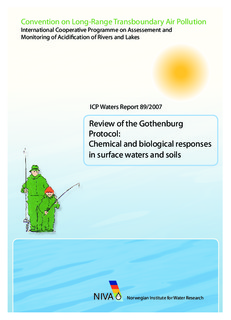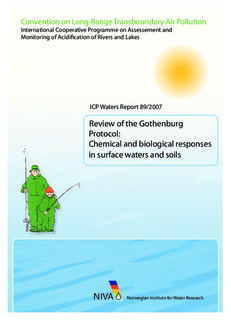| dc.contributor.author | Wright, R. | nb_NO |
| dc.contributor.author | Posch, Maximilian | nb_NO |
| dc.contributor.author | Cosby, B. Jack | nb_NO |
| dc.contributor.author | Forsius, Martin | nb_NO |
| dc.contributor.author | Skjelkvåle, B.L. | nb_NO |
| dc.contributor.other | Wright, R. - Project manager | nb_NO |
| dc.coverage.spatial | Europa | nb_NO |
| dc.date.accessioned | 2014-08-01T10:51:31Z | |
| dc.date.available | 2014-08-01T10:51:31Z | |
| dc.date.issued | 2007-08 | nb_NO |
| dc.identifier | 5475 | nb_NO |
| dc.identifier.isbn | 978-82-577-5210-1 | nb_NO |
| dc.identifier.issn | 1894-7948 | nb_NO |
| dc.identifier.uri | http://hdl.handle.net/11250/213786 | |
| dc.description.abstract | Monitoring data from ICP Waters and ICP Integrated Monitoring as well as other sources show clear and large regional recovery in surface water chemistry in response to the large decreases in deposition of sulphur and to a lesser extent nitrogen since the mid-1980s. Waters have become less acidic and less toxic to biota. At many sites sulphate concentrations now approach the low levels expected following full implementation of the Gothenburg protocol. Nitrate, on the other hand, does not show consistent trends, and most sites are far from steady-state conditions. Results of multivariate statistical gradient analysis suggest that coniferous defoliation, discolouration and lifespan of needles in the diverse phenomena of forest damage are explained by the combined action of ozone and acidifying sulphur and nitrogen compounds in air. Dynamic models and critical load mapping indicate that a significant number of sites in several regions of Europe will continue to be acidified after 2010. Biological recovery has begun in many regions, but lags behind chemical recovery. Future climate change will affect acidification and recovery. | nb_NO |
| dc.description.sponsorship | United Nations Economic Commission for Europe | nb_NO |
| dc.description.sponsorship | The Norwegian Pollution Control Authority | |
| dc.description.sponsorship | Finnish Environment Institute SYKE | |
| dc.publisher | Norsk institutt for vannforskning | nb_NO |
| dc.relation.ispartofseries | NIVA-rapport;5475 | nb_NO |
| dc.relation.ispartofseries | ICP Waters report;89/2007 | nb_NO |
| dc.rights | Navngivelse-IkkeKommersiell-DelPåSammeVilkår 3.0 Norge | nb_NO |
| dc.rights.uri | http://creativecommons.org/licenses/by-nc-sa/3.0/no/ | nb_NO |
| dc.subject | sur nedbør | nb_NO |
| dc.title | Review of the Gothenburg Protocol: Chemical and biological responses in surface waters and soils (ICP Waters report 89/2007) | nb_NO |
| dc.type | Research report | nb_NO |
| dc.rights.holder | Norsk institutt for vannforskning/Norwegian institute for water research | nb_NO |
| dc.subject.nsi | VDP::Matematikk og naturvitenskap: 400 | nb_NO |
| dc.source.pagenumber | 41 | nb_NO |
| dc.subject.keyword | sur nedbør | nb_NO |
| dc.subject.keyword | vann | nb_NO |
| dc.subject.keyword | jord | nb_NO |
| dc.subject.keyword | forsuring | nb_NO |
| dc.subject.keyword | acid deposition | nb_NO |
| dc.subject.keyword | water | nb_NO |
| dc.subject.keyword | soil | nb_NO |
| dc.subject.keyword | acidification | nb_NO |
| dc.relation.project | O-26357 | nb_NO |


